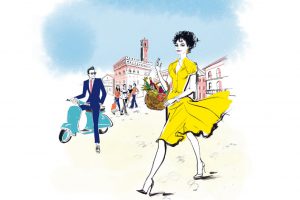
Topic(s): A. Identity & Social Relationships, B. Contemporary Life, Celebrations, Customs, & Traditions, Design and Aesthetics, Fashion and Clothing, Identity
"La bella figura" is a term used by Italian people in their everyday life which literally means "the beautiful figure".
La bella figura refers to dressing well and making a good impression but it is also about dignity, hospitality and politeness.
What is "la bella figura" and why is it an essential part of the Italian culture?
What does "fare bella figura" mean?
What habits are seen by Italian as "bella figura?"
You are going on a trip in Italy with your school and you will be staying in host families. In order to fit in with the locals, you are investigating further the “do’s and don’ts” of traveling to Italy and how to make "una bella figura" once you are there.
Youtube video in English on understanding the concept of "bella figura"
https://www.youtube.com/watch?v=wbomcwb8jOU
Students watch and listen to a video on the origin and tradition of "la bella figura". They are given a questionnaire to complete with multiple choice options. They have have to find the correct answers based on the information presented in the video.
I can identify and understand the origin and significance of "fare bella figura" and "fare brutta figura".
With a partner, students discuss their interpretation of "bella figura" and find examples of how to make "bella o brutta figura" in their own country. Students share their answers with the rest of class and see if there are some similarities with the Italian "bella figura".
I can describe customs and habits and compare them to other countries.
Students create a poster about the "do's and don'ts" to make 'Bella figura" in their country with written and visual representation in Italian. Using the structure "bisogna + infinitive" (=need to) and the verb "dovere" (=to have to) in the present tense. They have access to a dictionary to describe the different habits. They present their poster to the class in the target language.
I can describe "la bella figura" and present some customs in Italian using the structure "bisogna + infinitive" and the verb "dovere" in the present tense.
Authentic Italian articles on "bella figura":
https://www.proiezionidiborsa.it/alcune-regole-per-fare-sempre-una-bella-figura-in-pubblico-soprattutto-con-gli-estranei/
https://www.theitaliangentleman.it/cosa-non-fare-quando-si-e-ospiti-regole-base/
https://www.wikihow.it/Essere-un-Buon-Ospite
Students review articles on good manners in Italy and how to behave when you are a guest. They identify the main rules in the articles. Students may then write some questions that they have about "buone maniere" (=good manners) when staying in a host family in Italy.
I can identify the main ideas of each article and use the information to compare it with my own culture.
With a partner, students identify the do's and don'ts when staying in a host family in Italy using the information from the interpretive task. They share their ideas to the class a brainstorming activity and come to a group consensus.
I can discuss and analyze the do's and don'ts and good manners in Italy when staying in a host family.
Students create a guide of etiquette and good manner of what they think you should do or not when staying in a host family or visiting a country. Using the conditional ('dovresti'-you should / 'non dovresti' - you should not) and visual support in their guide. They can also include different persons ('dovrei' - I should / 'dovrebbe' - it should / 'dovremmo' - we should, etc.).
I can discuss and create my own do's and don'ts by using the conditional.
Il Galataeo in Italia - books of manners and rules of etiquettes in Italy. (Often referred to in la 'bella figura')
Students read some of the rules of the Galateo and use the information to formulate what rules of etiquette they follow in their everyday life and why.
I can read and analyse authentic information and make a list of rules of etiquette.
With a partner, students discuss in the target language and share their thoughts on the Galateo. They also discuss rules of "buone maniere" that they have in their home country and make connections and comparisons using the Venn diagram.
I can discuss my ideas and share my opinions and information on the Galateo in Italy.
Students create a short film (script and audio) explaining and illustrating at least 2 rules of etiquettes in their home country and their opinions about it in Italian. They should use a varied vocabulary (for example: good manners at the restaurant; good manners at school; etc.). They should include the conditional "dovresti" (you should) + verb infinitive + "bisogna" (need to) + verb infinitive.
I can give my opinions on good manners and compare them with different countries in Italian using the conditional and the structure "bisogna" + infinitive.
